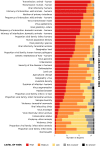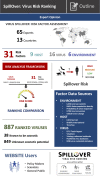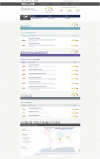Ranking the risk of animal-to-human spillover for newly discovered viruses
- PMID: 33822740
- PMCID: PMC8053939
- DOI: 10.1073/pnas.2002324118
Ranking the risk of animal-to-human spillover for newly discovered viruses
Erratum in
-
Correction for Grange et al., Ranking the risk of animal-to-human spillover for newly discovered viruses.Proc Natl Acad Sci U S A. 2021 Sep 28;118(39):e2115409118. doi: 10.1073/pnas.2115409118. Proc Natl Acad Sci U S A. 2021. PMID: 34544885 Free PMC article. No abstract available.
Abstract
The death toll and economic loss resulting from the severe acute respiratory syndrome coronavirus 2 (SARS-CoV-2) pandemic are stark reminders that we are vulnerable to zoonotic viral threats. Strategies are needed to identify and characterize animal viruses that pose the greatest risk of spillover and spread in humans and inform public health interventions. Using expert opinion and scientific evidence, we identified host, viral, and environmental risk factors contributing to zoonotic virus spillover and spread in humans. We then developed a risk ranking framework and interactive web tool, SpillOver, that estimates a risk score for wildlife-origin viruses, creating a comparative risk assessment of viruses with uncharacterized zoonotic spillover potential alongside those already known to be zoonotic. Using data from testing 509,721 samples from 74,635 animals as part of a virus discovery project and public records of virus detections around the world, we ranked the spillover potential of 887 wildlife viruses. Validating the risk assessment, the top 12 were known zoonotic viruses, including SARS-CoV-2. Several newly detected wildlife viruses ranked higher than known zoonotic viruses. Using a scientifically informed process, we capitalized on the recent wealth of virus discovery data to systematically identify and prioritize targets for investigation. The publicly accessible SpillOver platform can be used by policy makers and health scientists to inform research and public health interventions for prevention and rapid control of disease outbreaks. SpillOver is a living, interactive database that can be refined over time to continue to improve the quality and public availability of information on viral threats to human health.
Keywords: disease ecology; emerging infectious disease; public health; wildlife; zoonotic virus.
Copyright © 2021 the Author(s). Published by PNAS.
Conflict of interest statement
The authors declare no competing interest.
Figures



References
-
- World Health Organization , WHO Director-General’s opening remarks at the media briefing on COVID-19–11 March 2020. https://www.who.int/director-general/speeches/detail/who-director-genera.... Accessed 11 March 2021.
-
- International Monetary Fund (IMF) , World Economic Outlook, October 2020: A Long and Difficult Ascent (International Monetary Fund, Washington, DC, 2020).
-
- Carroll D., et al. ., The global virome project. Science 359, 872–874 (2018). - PubMed
Publication types
MeSH terms
Grants and funding
LinkOut - more resources
Full Text Sources
Other Literature Sources
Medical
Miscellaneous

